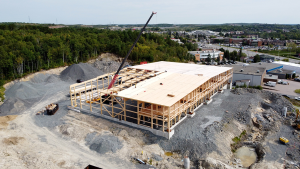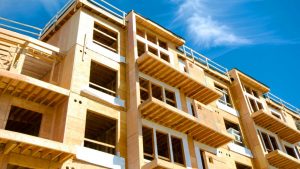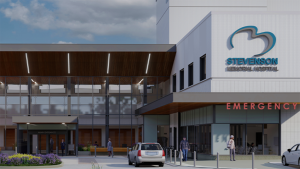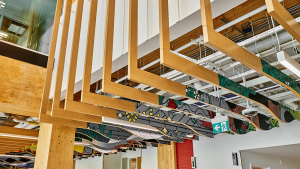Three members of the design and construction professions advocated for mass timber construction at the recent Construct Canada show without the aid of notes or the standard PowerPoint format.
Instead, they relied on their knowledge of and experience with the product to field a series of questions by moderator Brian Watkinson, principal at Strategies 4 Impact!
The official title of the seminar was: Mass Timber, Concrete, or Steel: What’s the Best Option for Your Project? But at various times all three emphasized that it isn’t always a case of choosing one material over another—rather there are many opportunities and requirements for hybrid structures incorporating a mix of materials.
There are also many projects where it simply doesn’t make economic or architectural sense to use mass timber, said Dominique Briand, CEO of Structure Fusion, a Saint-Augustin-de-Desmaures, Que.-based designer, manufacturer, and installer of both mass timber and hybrid structures.
“I’m not going to build a warehouse out of mass timber,” said Briand, noting it is considerably less expensive to use steel for what is a utilitarian structure.
Canada is becoming a world leader in mass timber construction, said Briand, whose foray into this sector began when he built his own timber house and then later founded a company specializing in high-end wooden home construction before starting Structure Fusion.
In Quebec, there is a strong focus on mass timber construction and that’s partly been driven by the provincial government’s wood charter initiative which is intended to increase the use of wood in non-residential, commercial, industrial, institutional and multi-family construction, plus road work, he said.
“We’re starting to see repeats not just one-offs,” said Briand in a reference to the fact timber builders in Quebec are starting to pick up other contracts from their existing clients.
One of the defining characteristics of mass timber buildings is that the timber is a 50 per cent structural support system and 50 per cent an architectural feature, while steel and concrete are intended to carry the structural loading, he said.
In a somewhat related comment, Mark Gaglione, building and material sciences specialist at EllisDon, said that mass timber structures have to be designed and built in a “holistic” manner because there is an extensive degree of integration of the various sections and components.
As an example, he noted the erection of the mass timber can proceed rather quickly but that the scheduling has to consider the progress of other trades such as the window installers. He likened that co-ordination to a collective journey of 10 cars where the first two cars race ahead of the others. “But they (all 10 cars) end up finishing at the exact same time.”
EllisDon has been “mapping out opportunities” in the mass timber field since 2015, the date when the Ontario government approved the construction of wood-framed buildings up to six storeys. Since that legislative change, there have also been advances in manufacturing technology, and greater marketplace acceptance of the material.
“Colleges and universities are waving the flag,” said Gaglione, in a reference to a number of mass timber buildings either been constructed or planned on campuses throughout Ontario.
Craig Applegath, principal and founding partner of DIALOG’s Toronto studio, was the third speaker and he introduced himself by telling the audience: “I’m passionate about mass timber.”
That passion began with his firm’s design of York Region’s Bill Fisch Forest Stewardship and Education Centre which was built almost entirely out of Forest Stewardship Council (FSC) certified wood, he said.
Located near Uxbridge, Ont., the centre won the Public Project of the Year at the 2016 Ontario Public Works Association Awards in the category of historic restoration and preservation.
A connection of sorts was made to the project when an audience member challenged, or at least questioned, if the ability of trees to sequester carbon is overestimated.
Applegath’s response was that timber for buildings should only be used if it has been harvested from certified sustainable forests and not from forests that have been clear cut.
Touching on the economics of building with different products, he acknowledged that it varies from region to region. A five-storey wooden structure in Victoria, B.C. is less expensive to erect than concrete or steel because of the abundance of skilled trades who have experience in working with it.
Applegath seized on a closing question to all the panellists on what they would say about mass timber if they had the opportunity to meet with Prime Minister Justin Trudeau. He suggested government policies promoting its use would be endorsed by all the political parties. The NDP and the Greens are looking for ways to promote sustainability, the Bloc Quebocois would be on board because of the economic importance of timber production in Quebec, and so would the Conservatives because it would win favour with their rural supporters — especially in Northern Ontario where timber is also vital to the economy.











Recent Comments
comments for this post are closed